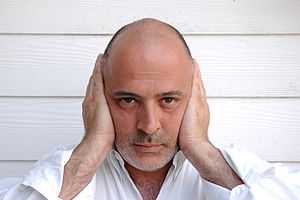Eduardo Montes-Bradley
| Eduardo Montes-Bradley | |
|---|---|
|
Portrait, 2010 | |
| Born |
July 9, 1960 Córdoba, Argentina |
| Nationality | USA |
| Occupation | Filmmaker, photographer, writer |
| Years active | 1979–present |
| Spouse(s) | Soledad Liendo |
| Relatives | Ricardo Ernesto Montes i Bradley, Eduardo Bradley, Juan Alberto Montes |
| Awards | Jefferson Trust Award [1] Silver Eagle[2] 2015 Best Documentary Richmond International Film Festival.[3] |
| Website | |
|
www | |
Eduardo Montes-Bradley (born July 9, 1960) is a filmmaker, photographer and author.[4][5] His biographical film-portraits on writers, composers, artists, and historical figures have been translated into several languages. His documentary Samba On Your Feet, a study on the origins of Brazilian Carnival and Samba traditions, gained the recognition of African American Studies.[6][7][8][9] Most recently, Montes-Bradley produced and directed "Julian Bond: Reflections from the Frontlines of the Civil Rights Movement" (2012), "Rita Dove: An American Poet" (2014),[10] and biographical documentaries in the ongoing series of "Writers Made in Brazil”.[11][12]
Early life
Montes-Bradley was born in Córdoba, Argentina to Nelson Montes-Bradley, founder of Discos Qualiton and Sara Kaplan. The family name originated from the union in 1893 of Juan A. Montes Ziegler of Galician and German ancestry, and Elvira Bradley, descendant of Thomas Osgood Bradley of Haverhill, Massachusetts.[13] In 1961 his parents relocated to Rosario, and by 1965 the family is living in Buenos Aires. The cultural ambiance in the capital city, and the family relationship with the arts were crucial during his formative years. Montes-Bradley attended public school, was brought up agnostic and atheist in a progressive, predominantly left-wing radical environment. In 1973 Montes-Bradley is accepted to the Colegio Nacional Nicolás Avellaneda.[14] May 25, 1973, marked the end of seven years of military rule. General Alejandro Agustín Lanusse steps down as president and Héctor José Cámpora is elected on a Peronist ballot. Shortly after Héctor Campora's inauguration, former president and founder of the Peronist Party, General Juan Domingo Perón returns from exile in Madrid where he had spent eighteen years under the protection of Generalisimo Francisco Franco.[15] On September 11, 1973 Salvador Allende is overthrown in a bloody military coup led by General Augusto Pinochet in neighboring Chile. It was a time of profound political turmoil. Montes-Bradley became involved as a student in political activism.[16] The deaths of Pablo Picasso, Pablo Casals, Pablo Neruda and Víctor Jara, all of which occurred during 1973, had a profound impact in an entire generation. Montes-Bradley will frequently recall 1973 as turning point: "Not because of anything that I might have believed on then, which I most certainly don't believe in now, convictions come and go; but because of the extraordinary experience of living in a home full of music and poetry within the boundaries of a country at the brink Civil War." Three years later, General Jorge Rafael Videla ousted president Isabelita, thus inaugurating an era of state-sponsored terror and persecution resulting in the death and despairing of thousands, while many were forced into exile.
Career
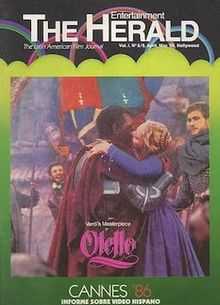
Two years after the military coup of 1976, Montes-Bradley relocated in New York City [17][18] where he worked as collaborator and correspondent to The Hollywood Reporter and El Heraldo del Cine, a Buenos Aires-based trade publication catering the film industry. His first contribution to filmmaking can be traced to Margareta Vinterheden's Man maste ju leva, Sweden, 1978.[19] In the early 1980s Montes-Bradley worked as assistant editor, and editor in documentaries focusing on the Nicaraguan and Salvadorean civil wars. In 1984 Montes-Bradley is living California as publisher-editor of The Entertainment Herald.[20] By 1986, EM-B was working as a Director of International Sales for Filmtrust Motion Picture Licensing, an independent production and distribution company based in Los Angeles.[21] In 1989 Montes-Bradley teamed-up with producer Javier Gracia to write, produce, and direct Double Obsession,[22] a straight-to-video thriller released by Columbia Tri-Star starring Maryam D'Abo, Margaux Hemingway, Frederick Forrest.[23] In 1995 Montes-Bradley married actress Sandra Ballesteros, leading-lady in The Kidnapping, a politically-incorrect satiric-parody on Latin American guerrilla warfare in the 19070’s. The film became a cult movie as well as Montes-Bradley's last known fiction.[20] In 1997 Montes-Bradley returned to the documentary format with "Soriano"[24] a biographical sketch based on the life and works of Argentine journalist and novelist Osvaldo Soriano. It was the first in a long list of documentary portrayals on intellectuals, artist, philosophers, and writers to follow. Montes-Bradley has been credited as a director under pseudonym inspired on fictitious character such as "Diana Hunter", the blind lady-director who "one day went deep into to the forest and was forever lost", and Rita Clavel who followed on the footsteps of Hernán Cortés on "Crónicas Mexicas".[25] Although a constant in his work as a filmmaker and a writer, the actual number of pen-names used by Montes-Bradley is uncertain.
"Montes-Bradley is a provocative filmmaker who inaugurated a style by interrogating paradigmatic icons of the Latin American culture,çand by doing so with in the spirit of a cultural agitator."
—Alejandro Ricagno, La Cinémathèque, Toulouse, March 28, 2003.
Published work
Montes-Bradley’s published work comprises documentary, fiction, short and experimental films, music-videos; books (fiction and non-fiction), articles, and photography are detailed further under "Bibliography".
Documentary Films
2010–2015
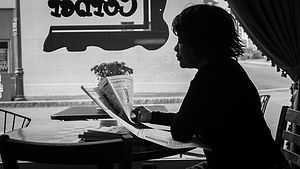
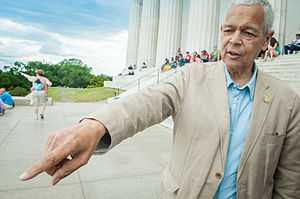
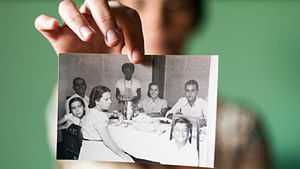
Unearthed and Understood. Heritage Film Project | University of Virginia Collection, 2014. Produced for the President’s Commission on Slavery and the University, University of Virginia. The documentary features interviews with Larry Sabato, Rita Dove, Julian Bond, Ervin L. Jordan, Jr, Kirt von Daacke, Kelley Deetz, Lynn Rainville, Marcus L. Martin, Maurie McInnis, and Cinder Stanton, author of "Those Who Labor for My Happiness: Slavery at Thomas Jefferson's Monticello". The film was presented at the symposium "Universities Confronting the Legacy of Slavery on October" in October 16, 2014 in Charlottesville. HD | 18 minutes.
White: A Season in the Life of John Borden Evans. Heritage Film Project, 2014. HD | 30 min. 2015 Best of Festival Documentary Short, Official Selection at the Richmond International Film Festival.[26] The documentary explores the working artist John Borden Evans, capturing the quiet and the quotidian elements of life in Virginia's countryside. "White" is part of a series of artists at work which includes Ernesto Deira, in Paris, Perez Celis, in Little Haiti, Andres Waissman, in Palermo, Buenos Aires, and Humberto Calzada in Coral Gables. HD | 30 minutes. Shot during between September 2013 and March 2014. The title is in reference to the visual fact the production took place in the snow, white is also the prevalent base calor on John Borden’s paintings during the period in which the film was produced. Main Location isNorth Garden, VA. Original Music by Alice Parker. Distributed by Alexander Street Press.[27]
Rita Dove: An American Poet. Heritage Film Project | University of Virginia Collection, 2014. Distributed by Filmakers Library - Alexander Street Press, USA.[28] Color and Black and White, HD, 50 min. Biographical sketch of Rita Dove. The film, premiered in Charlottesville on January 31, 2014, is structured around a considerable number of original interviews, and a collection of home-movies and early childhood images from the archives of the Dove family in Akron.[29] In the documentary, Rita Dove evoques family stories going back to the Great Migration, childhood experiences, segregation, the March on Washington, meeting Nixon at the White House, her fascination with music, and with the cello in particular, and a first experience abroad when her father (Ray Dove) drove the family on a road-trip to Mexico.[30][31][32] The film concludes after Ms. Dove’s returns from Germany where she studied at Universität Tübingen on a Fulbright Scholarship.[33]Rita Dove: An American Poet, does not explore the public figure and literary career of the poet laureate, ir rather focuses in the personal experiences, and process leading to the literary personae,[34] and the celebrated American poet that Rita Dove would ultimately become.[35]
Child of the Forest: The Story of Yona Bromberg. Heritage Film Project, (2014). The film documents the trials and tribulations of Holocaust survivor Yona Bromberg. During the interview Bromberg recalls being herded -along with the rest of the Jews in Rokitno- to the market where the occupying German forces open fire killing almost everyone. Yona Bromber, her mother and sister run for cover into the forest where they lived among other refugees until Liberation.[36] The interview was shot in Hallandale where Ms. Bromberg resides during the Winter.
Saavedra: Between Berlin and a place called Peixoto''. Heritage Film Project + Writers Made in Brazil, 2013. HD, 30 min. (Portuguese) Produced in part with a grant from the Brazilian Ministry of External Relations | Embassy of Brazil, Washington, D.C. Biographical Sketch about Brazilian author Carola Saavedra. Filmed on location in Berlin and Rio de Janeiro. Premiered October 9, 2013 at Frankfurt International Book Fair.[37][38][39]
Julian Bond: Reflections from the Frontlines of the Civil Rights Movement. Heritage Film Project | University of Virginia Collection, 2012. Distributed by Filmakers Library - Alexander Street Press, USA.[28] Color and Black and White, HD, 34 min. Portrait of social activist and former Georgia legislator Julian Bond. Bond approaches the story of the Civil Rights Movement in the United States from a personal perspective. "Bond's father was the first African-American president of Pennsylvania's Lincoln University, and the family hosted black luminaries in education and the arts, but Bond recalls growing up in the era of "separate but equal" laws".[40] Bond also talks about his early involvement with the Civil Rights Movement, his nomination for vice president of the United States in 1968, and the Georgia legislature's efforts to prevent him from being seated as a representative on the grounds that he had not supported the Vietnam War. The film explores the 1963 March on Washington, Martin Luther King Jr., the assassinations of King and President John F. Kennedy, and Lyndon B. Johnson's impact on U.S. race relations. On this film Bond also offers his own insights, and adds some personal revelations, such as the fact that he was a published poet during his college years. The film closes with a montage of major African-American figures from Frederick Douglass to Spike Lee.[9] Julian Bond, Premiered at the Virginia Film Festival on November 4, 2012.[41]
Lisboa. Heritage Film Project + Writers Made in Brazil, 2012. HD, 30 min. (English) Produced in part with a grant from the Brazilian Ministry of External Relations | Embassy of Brazil, Washington, D.C.. Based on the experiences of Brazilian Writer Adriana Lisboa now living in Louisville, Colorado. Shot in February 2012 on location in and around Boulder, Co. Premiered on WHTJ PBS / WCVE PBS, Virginia, also aired by Rocky Mountain PBS. Italian Avant Premier with Italian subtitles at Festivaletteratura | Mantova, Italy on September 5, 2014[42]
Loewenstein. Heritage Film Project | University of Virginia Collection, 2012.[43][44] Portrait of Jared Loewenstein the librarian whose commitment, and dedication were instrumental in the preservation of Jorge Luis Borges's first editions, manuscripts, letters and drawings.[31][45] These documents known as the Jorge Luis Borges Collection, are preserved at the Albert and Shirley Small Library Special Collections at UVa.[46]
Baragiola. Heritage Film Project | University of Virginia Collection, 2011.[47] First on a series U.Va. Collection. The film is a biographical sketch on Raúl Baragiola, Alice and Guy Wilson Professor of Engineering Physics and Materials Science. The film was shot on location in Charlottesville.
Waissman. Heritage Film Project, 2010. HD, 30 min. Documentary based on the life and works of contemporary artist Andrés Waissman. Produced by Soledad Liendo. "Waissman" premiered on November 23, 2010 on WPBT Channel 2 (PBS). 30 min. 16:9 HD[48][49][50]
The Celebration. Heritage Film Project, 2010. HD, 30 min. Documentary commemorating the anniversary of the Aventura Turnberry Jewish Center in Aventura. The film includes an account from Donald Soffer on the founding of the city of Aventura, a statement from Susan Gottlieb the Mayor of the City of Aventura discussing the relationship between the city and the Jewish community, and the testimony of Holocaust survivor Victor Cynamon (Lublin, Poland, 1923) with regards to his ordeal at Schlieben and Buchenwald camps in Germany, and the Ghetto of Lublin.[51][52][53][54]
Calzada. Heritage Film Project, 2010. HD, 30 min. Produced by Soledad Liendo.[55] Documentary on the life and works of Cuban-American artist Humberto Calzada. Theatrical premier was on January 7, 2010 at the Tower Theatre; TV premier on January 12, 2010 WPBT Channel 2 (PBS). Featuring Humberto Calzada, his early life in Havana, Cuba before the Cuban Revolution that brought Fidel Castro to power, the first years in exile in Miami, and details on his current life as a highly regarded visual artist in the Caribbean. Original Music by Gerardo Aguillón (violin) and José Angel Navarro (guitar). 30 min. 16:9 HD[56]
2007–2010
Low Blows: La Raulito. The documentary follows Mary Esher Duffau aka "La Raulito", the fan-mascot of Boca Juniors and eccentric folk character of Buenos Aires. La Raulito as Duffau was known, was immortalize in a film by the same name directed by Lautaro Murúa in 1975. However, in this film the director follows the real character during the last days of her life. Low Blows: La Raulito premiered at Mar del Plata International Film Festival on December, 2009. Latin American Selection.[57] Produced by Eduardo Montes-Bradley, directed by Emiliano Serra.
Evita (Documentary). 2007. Documentary on Eva Duarte, former First Lady of Argentina. Evita, illegitimate child without social or economic standing, was determined to make it big in the world of entertainment. Her love affair with a rising political star (Juan Domingo Perón) transformed her into a vital part of Perón's plans to seduce a nation. The charming Evita became a skilled public speaker that fitted perfectly with politics in Argentina. Just imagine Marilyn Monroe with the charisma of Princess Diana, elevated by Joseph Goebbels´s propaganda machine as the indisputable Spiritual Leader of the Nation. The documentary appears to be fair, perhaps the first biography on the subject that strives to be balanced. "Evita" was screened at the Virginia Film Festival, in Charlottesville, on November 4, 2011.[58][59]
Deira. 2007. Biographical-sketch on renowned artist Ernesto Deira. Screened at the National Art Gallery, MNBA (Museo Nacional de Bellas Artes), during a retrospective exhibit commemorating the both anniversary of Deira’s passing. "Deira" includes rare 8mm footage captured by the artist during a visit to Belgium, and interviews with Olga Galperin and Luis Felipe Noé and others.
2004–2007
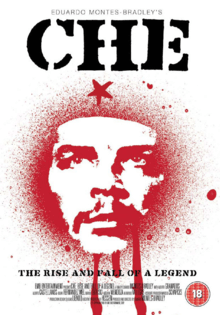
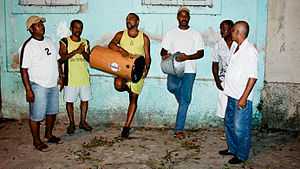
Che: Rise & Fall. DVD Release Date: July 13, 2006 by Westlake Entertainment, German Release, 20007, Latin American premiered on NatGeo. CHE: Rise and Fall, follows on the trials and tribulations of Ernesto Guevara in the words of old friends and comrades-in-arms.[60] Includes the testimonies of Guevara’s friend Alberto Granado, and members of his elite military entourage Alberto Castellanos, Enrique Oltuski, Argudín Mendoza, Enrique “Pombo” Villegas. Locations: Havana, Congo, Bolivia. Super 16mm. Aspect Ratio: 1.66:1
The Great Pretender. Official Selection of the International Film Festival of Buenos Aires (BAFICI), 2007. Released in Uruguay as "No a los papelones". Release in Argentina as El gran simulador’’. The documentary presents Montes-Bradley's quest to find Nahuel Maciel, a journalist who fifteen years before fooled the press core by posing as a native from the Mapuche nation in Patagonia. Disguised as Chief Nahuel the impostor sold alleged interviews with Gabriel García Márquez, Umberto Ecco, Mario Vargas Llosa and others to prestigious local newspapers such as El Cronista Comercial. Nahuel Maciel later published a book with a bogus interview with the Colombian Nobel Prize preceded by a foreword by Eduardo Galeano. Montes-Bradley finally finds Maciel some 300 miles from Buenos Aires in a frontier town called Gualeguaychú where Maciel was working close to the leadership of a group of environmentalists battling a paper-mill in the Argentina-Uruguay border. The film is witty, provocative and politically incorrect.[61] El gran simulador was initially banned from theaters in Argentina for its politics, and it was effectively released in Uruguay (across the border) with good B.O. results.[62][63] However, the film was shown as part of the Official Selection of the Buenos Aires International Independent Film Festival (BAFICI), 2007.[64] On the director’s request the film did not participate “in competition” to avoid further turmoil.[65] Two years later, in April 2008, El gran simulador was finally released in Argentina by Editorial Perfil, the opposition media conglomerate own by Jorge Fontevecchia. HD | 75 min. 35 mm.
Samba On Your Feet USA | Brazil 2005. The documentary explores behind the scenes of Samba and Carnival in Rio de Janeiro, revealing the preambles of the cultural clash leading to Samba an indigenous cultural tradition in Brazil. Actor-Narrator Haroldo Costa explains on the film that Samba is the direct result of a complex cocktail of religions and beliefs. African slaves adapted many of their traditions to the cannon of the Catholic conquistadores; and also the Native indigenous brought their own and quite remarkable cosmogony to the fusion. The result of all that is what we called today Samba. And what today is considered the first samba ever, was a composition played during the Carnival of Rio de Janeiro in 1917.[66] Multiple use of archival material. "Samba On Your Feet" includes interviews with veteran sambista Xango da Mangueira[67] who would in-camera recalls the early days of Carnival when he and his fellow sambistas were treated like vagrants, harassed and arrested by the police. Mae Helena D'Oxosse, a priestess in the umbanda tradition, incorporates samba in her religious practices and carries on a tradition among her working-class followers that is five hundred years old. "Samba On Your Feet" has been selected to participate at the Toulouse Latin American Film Festival 2008, at the Rio de Janeiro International Film Festival 2006, Buenos Aires Independent Film Festival (BAFICI) 2007 and Toronto Latino Film Festival.[68][69] The film is distributed by Filmmakers Library. Worldwide rights by Alexander Street Press.
From Frankfurt to Humahuaca’'. Contrakultura, 2005. Second in the trilogy of documentaries directed by Norberto "Negro" Ramírez and produced by Montes-Bradley on the culture of la Puna, mainly Jujuy and Salta provinces. From Frankfurt to Humahuaca focuses on the life and works of Jorge Lovisolo, disciple of The Frankfurt School of philosophy, author of numerous essays. The film deals with Lovisolo's obsessions in a sort of self-imposed exile in Salta; his takes on religion within the local communities, the thoughts of Walter Benjamin, Herbert Marcuse, Theodore Adorno and others.[70]
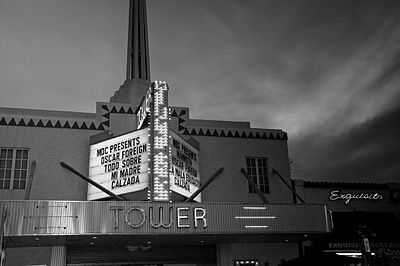
Kopla Vera. Contrakultura, c. 2006. First of a trilogy by director Norberto N. Ramírez on intellectuals residing in the Northwest region of Argentina known as la Puna, mainly Jujuy and Salta provinces. Kopla Vera focuses on the life and works of Jesús Ramón Vera, author of numerous verses inspired in the liturgical carnival of Jujuy.
El hombre invisible. The documentary explores the work of early film editors of News Reel in Argentina during the 1940s and through the 1960s. El hombre invisible'’ was produced by Montes-Bradley and directed by Eduardo López formally an editor himself.
Yo y el tiempo. The film features legendary poet-composer Juan José Botelli, a native and cultural icon in Salta. This film is the third part of a trilogy produced by Montes-Bradley and directed by Norberto “Negro” Ramírez, formerly a sound recordist in other films directed by Montes-Bradley.
Marcos Ribak aka Andrés Rivera. Biographical portrait of Andrés Rivera author of "La revolución es un sueño eterno". The film was proimarely shot in Córdoba where the author lived with his second wife Susana Fiorito. The film contributes to shed light on Polish Jewelry immigration to Argentina, and in the political life of young members of the Communist Party in Buenos Aires during the Peronist regime (1945-1955).
No matarás. Documentary on Marcelo Birmajer, an irreverent Jewish-Argentine writer, who´s political views, largely at odds with the overwhelming "progressive"-minded cultural milieu in Buenos Aires are largely responsible for his continue political isolation. In the film Birmajer presents himself to the audience as a lost soul somewhere between Buenos Aires and a not so distant Middle East; holding a tight grip on the umbilical cord that his Jewish-mother preserves intact for generations to-come. The film was produced shortly after the terrorist attack to AMIA and the Israel Embassy in Buenos Aires which recently gained renewed attention in the media after the presumed murder of Alberto Nisman. In the film Birmajer accuses Iran as the primary instigator of the terrorist attacks in Buenos Aires.
Insurgentes. The documentary approaches the intricate connections between revolutionary organizations in Chile (MIR), Argentina (ERP), and Uruguay (Tupamaros) in the 1970´s. The film was produced by Montes-Bradley and directed by Pablo Doudchitzky.
Ecce Homo. This documentary is based in the last known interview to Juan Filloy when he was already 105 years old. The original interview was conducted by Ana Da Costa from Biblioteca Nacional.
Crónicas Mexicas. The documentary follows on the foot-steps of Hernán Cortés from the landing beaches of Veracruz on golf coast of Mexico, to Tenochtitlan, the ancient capital of the Aztec. Montes-Bradley (as Rita Clavel) teams-up with Martín Caparrós who becomes the omnipresent and omniscient protagonist of this journey through geography and time. Caparrós acute sense of irony becomes a permanent fixtures throughout the film, provoking the audience into uncharted: the politically incorrect history of Latin America.
Las memorias del señor Alzheimer. The sole protagonist in this film is Jorge "Dipi" Di Paola, a dadaist-exentric, writer-poet, an unconventional character of the Buenos Aires underground during the 1970s. The film was shot in 2007, shortly before Di Paola's death in Tandil, some 450 kilometers from the capital of Argentina. In the film Di Paola, recalls the times in which he and his mentor Witold Gombrowicz shared an apartment in Buenos Aires first, and later in Di Paola's home-town of Tandil. Produced by Montes-Bradley and directed by Sergio Belloti.
Negro sobre blanco. Legendary negative cutting Margarita Bróndolo recalls the early days of cinematography in Argentina. As an employee of Estudios San Miguel and other pioneer studios in Buenos Aires, Bróndolo worked alongside iconic figures of the golden era of film such as Eva Duarte . The documentary abunds in newsreels, and clips from some of the most celebrated film titles of Argentina. Montes-Bradley commissioned Eduardo López to direct "Negro sobre blanco". López, himself a local celebrity having edited over 100 titles and worked alongside some of the best known directors in Argentina such as Academy Award Nominee Adolfo Aristarain. Produced by Montes Bradley and directed and edited by Eduardo López.
La oficina. Documentary by first-time director Blas Eloy Martínez, son of laureate Tomás Eloy Martínez. The plot is set in the background of a red-tape paradise in the institutional nightmare of Argentine bureaucracy. "Office of Notifications" (as translated from the original title), shown life in the office or department is which all court notices are prepared and later delivered. The film centers on the lives of the bureaucrats and the art of delivering citations.
Una cierta mirada. Built as a series of conversations with Juan José Sebreli (philosopher), is perhaps one of the most interesting of the documentaries on writers by Montes-Bradley. Sebreli recalls his entire life in front of camera taking the audience for a ride through timeless Buenos Aires. Sebreli's extraordinary perception of the surroundings, the arts, the architecture and the music of the city he was born in and he loves is a constant throughout the entire film. In a way, this doc can be watch as a 20th-century Tour Guide of Buenos Aires, a sketch on Peronism and yet, more.
Dirigido por.... Interviews to some of Argentina's best known directors and filmmakers on the art of filmmaking in Argentina. Includes the contributions of Adolfo Aristarain, Academy Award Winner for Best Foreign Film Luis Puenzo, Lucrecia Martel, David José Kohon, Anibal DiSalvo, Daniel Burman, Mario Levin, Edmund Valladares, and others.
Planeta Bizzio, Documentary on the life and works of Sergio Bizzio, an off beat-poet, playwright and novelist. Interview conducted by Nadina Fushimi.
1998–2003
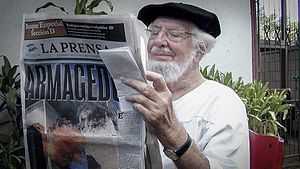
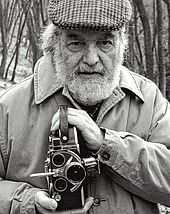
Witness of a Century. Original title: “testigo del siglo". Film based on the memoirs and recollections of Ismael Viñas: legendary political figure, economist, founder of Movimiento de Liberación Nacional (MALENA), former Undersecretary of Culture during the Revolución Libertadora. Viñas reappears in front of camera after twenty-six years in self-imposed exile, first in Israel and finally in the US. During a series of conversations with Montes-Bradley in Florida, USA, Viñas reflects on his youth, on his brother David, on his father, a well political character during the times of Hipólito Yrigoyen, and a Federal Judge in Patagonia during the uprisings portrayed in Rebellion in Patagonia[71] in the early 1920s. Viñas also recalls his imprisonment during the Peronist period, and with particular emphasis his relationship with Ernesto Che Guevara, and Salvador Allende amongst many other relevant figures of the period. On release, the film caused somewhat of a commotion. It was acclaimed and criticize by extremist elements on the right and particularly on the left where the Ismael Viñas portrayed on the documentary was perceived as a traitor to the Marxist principles he once so strongly embraced.[72][73] Directed by Montes-Bradley as Diana Hunter. Premiered at the Buenos Aires International Festival of Independent Cinema (BAFICI).
El equilibrista [74] Not much is know about this documentary based on the trials and tribulations of writer Dalmiro Saenz.
Deliciosas perversiones polimorfas. Intimate portrait of Alberto Laiseca, a cult literary figure of Buenos Aires better known for his fictional metaphysics. The film explores the relationship of the writer with his father, a rural family doctor living in province of Córdoba. References to Edgar A. Poe, William Shakespeare and the imminent arrival of the Antichrist are a constant throughout.
Recóndita Armonía. Mario Diament is a journalist and professor of journalism at the University of Miami In this documentary Diament recalls Jacobo Timerman and the years prior to and after the military coup of 1976 in Buenos Aires.
Pérez Celis. A portrait of Pérez Celis executed during the period the artist resided in Miami. The film captures the artist at work in his atelier in Little Haiti discussing his motivations, influences, creative process, technics. Celis is also shown drawing sketches and sharing stories about his native Buenos Aires in the mid 1940s.[75]
Le mot Juste. The documentary tracks Héctor Tizón to his hometown of Yala in Jujuy, Argentina. In a series of interviews with Montes-Bradley the novelist recalls childhood, and the traumatic experience on living on the edge of two extremely different cultures: the Quechua universe of his native homeland, and the Spanish culture of the conquistadores.[76] In the film Tizón explores the idea of exile in different directions with particular emphasis to the exile of the native inhabitants of the Puna in a territory dominated by the Spanish Culture and Catholic traditions. Tizón also talks in this film about his personal experience in exile during the dictatorship of Jorge Rafael Videla.
La otra orilla. Biographical sketch on writer and psychotherapist Luis Gusmán. The film follows on the footsteps of Luis Gusmán from Avellaneda, in the peripheral and less privilege southern settlements, to the middle class and hipster Palermo in Buenos Aires. The film includes previously unknown tango recordings of Luis Gusmán´s father.
Saludablemente en pelotas. Biographical sketch on Juan Sasturain, journalist (Pagina/12), and fiction writer better known for his collaboration with comics artist.
La célula fugitiva. Biographical sketch of journalist José Pablo Feinmann. The title translates into "The fugitive cell" and alludes to the protagonist survival to a cancer diagnosis during the repressive government of Isabel Peron and the Triple A.
Desandando el tiempo. Biographical sketch of poet Juan Jacobo Bajarlía (1914-2005). Produced by Eduardo Montes’Bradley and Directed by Rodolfo Durán as "Valentina Carrasco".
En el nombre del padre. Biographical sketch of Argentine short-story writer Ana María Shua.
Espléndida decadencia. Biographical sketch of novelist Daniel Guebel.
Cortázar: apuntes para un documental (Cortázar: Notes for a documentary). The documentary approaches Julio Cortazar's political views and perspectives on the Latin American Left.[77][78][79][80][81] and with Carole Dunlop in Paris. The film includes previously unseen footage from Cortazar´s home movies filmed in India next to his first wife Aurora Bernárdez, and Octavio Paz.[82] The film includes the testimonies of intellectuals in Europe and Latin America such as Claribel Alegría, Ernesto Cardenal, Manuel Antín, Carlos Montemayor, and Sergio Ramírez among others. Locations included Managua, Buenos Aires, Paris, Madrid and Rome. The film was nominated by the Argentine Association of Film Critics for best documentary in 2003.[83]
Los cuentos del timonel. Biographical sketch on Osvaldo Bayer, a controversial political figure and historian born in Argentina in 1927. The film was shot on Bayer's residence in Linz am Rhein, Germany.[84] The film was awarded Best Documentary by the Argentine Ass. of Film Critics in 2002.
Harto The Borges. Documentary on Jorge Luis Borges.[85] The film includes portions of a rare TV interview with Borges and María Kodama produced by Eduardo Rosas in celebration of the writer's 80th birthday. It also includes interviews with Franco Lucentini, Martín Caparrós, Franco Lucentini, and Ariel Dorfman. Harto The Borges was shot in Milan, Rome, Paris, Geneva and Buenos Aires.[86][87][88][89][90] Harto The Borges had a theatrical release in Buenos Aires on September 2000 and was well received by the local critics.[91] Most recently the film was presented in digital format on Diario Clarín's literary magazine "Revista de Cultura Ñ" under the title: "Harto The Borges: Ten Years After"[92]
Soriano (The documentary). This biographical documentary on Osvaldo Soriano includes a rare 16mm experimental short film by Soriano and friends Tandil.[93] Soriano was shot in Paris, Rome and Buenos Aires following on the footsteps of Osvaldo Soriano into exile in the 1970s. The film is not a celebration of Soriano but rather a fair and balanced approach to his life through the voice of friends and detractors. With testimonies by Rodrigo Fresán, Juan Forn, Martín Caparrós, Osvaldo Bayer, Eduardo Galeano and more.[94][95][96][97][98][99]
Fiction Films
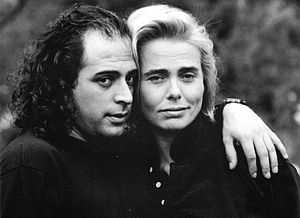
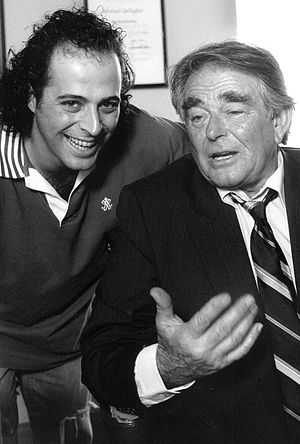
El sekuestro (The KidNapping) Iruña Films, 1997. Satire-Farse. Starting Sandra Ballesteros and Rodolfo Ranni. El Sekuestro is set in Rio Hondo, an imaginary Latin American nation where a band of revolutionary wannabes kidnap the wrong man, one no one is prepared to pay a ransom for.[100] The critics hammered the film following its premier at the Mar del Plata International Film Festival. However, The KidNapping remains the director's favorite to this date.The film was shot in South Beach in 1995 and, on November 4 of the same year Montes-Bradley married the leading-actress Sandra Ballesteros.[101] The film is a political farce taking on the events that so profoundly marked Argentine society during the nineteen seventies. It has been said that the plot is an excuse to mock the struggle of the guerrilla organizations that confronted the military regime led by General Jorge Rafael Videla.
Double Obsession. Drama. Starring Margaux Hemingway, Beth Fisher, Scott Valentine, Jamie Horton and Frederic Forrest. Edited by John Venzon. TriStar Columbia / Reivaj Films, 1992. The film falls in the B-Movie category which did well with distributors in the eighties and nineties, particularly in the straight to video and cable markets. Double Obsession was shot on 35mm on campus at the University of Colorado at Boulder. Montes-Bradley hardly ever talks about this film written by himself in collaboration with Jeffrey Delman and Rick Marx. The film was also known as Mirror Image.[102][103][104][105][106]
Smoothtalker. Thriller. Starring Blair (Lisa) Weikgenant as Lisa Charles, Peter Crombi as Jack Perdue, Stuart Whitman as Lt. Gallagher, Paul Raci as Peri and Burt Ward. USA, 1992. Original score by Tony Roman; Production Design by Brian Densmore. US Release: June 18, 1992
Man maste ju leva’. Actor. Film Directed by Margareta Vinterheden. Sweden, 1978. Very little is know on this first movie.
Short films
La Ventana de Leon Rozitchner. Independent, 2011.[107][108] Anecdotical documentary with philosopher León Rozitchner. Shot in Buenos Aires, Argentina.
Tríptico Vertical, USA, 1986. Not much is known about the nearly fifteen minutes art-documentary on Madres de Plaza de Mayo. It was shot in Buenos Aires shortly after the return to democratic rule. Music by Julio Lacarra.
American Manifesto, Writer, Producer, Director, Editor. USA (1993). American Manifesto premiered at the Buenos Aires Independent Film Festival (BAFICI) in 2005. It was shot in a club called Muddy's, in Denver, in the winter of 1993. The protagonist name is Steve, last name unknown. The film was produced on Hi-8mm and it was shoot in-one take. Steve has just been released from jail and he is quite unhappy with America where says what prevails is a dysfunctional "shistem". The film became a cult film in internet and still can be found in several YouTube-like sites.
Music videos
Montes-Bradley directed music-videos at odds with the dominant trends at a time in which MTV Latino was still in the experimental stage. Rumbera, by Willy Chirino, (Sony Music, 1994 is a cult video extravaganza shot in one single take of 7 minutes. Rumbera was shot in a South Beach cabaret and included dancing-monkeys, transvestites, fire-eaters, a salsa-band, dancers and almost a hundred extras. Rumbera opened the doors to salsa in the regular basis in MTV Latino, until then, exclusively focused to Rock, Pop and ballads from South America. Rumbera, shot on S-16 mm, screened and compete in Havana, Cuba at the Festival Internacional del Nuevo Cine Latinoamericano, in December 1994. That was the first time the public had the opportunity to see Willy Chirino on the Cuban screen where he remains, like Olga Guillot, strictly blacklisted. Another off-beat music-video by Montes-Bradley was Dale Pascual by the Argentine pop-group "Los enanitos verdes". Dale Pascual was shot in 35mm in La Cava, a slum in San Isidro, some 20 miles North of the City of Buenos Aires. The track spells out the hardships of the have-not in Argentina. La Cava provided the setting typical of neo-realism which emphasized the hard living conditions, unemployment and recession. To underline the sacrifice the director staged the crucifixion of a naked child. The image was too much for the networks in most Latin American countries. In Chile the film was censured and MTV refused to play it across the board. Dale Pascual marked a turning point and the end of Montes-Bradley's career as a music-video producer/director.
Bibliography
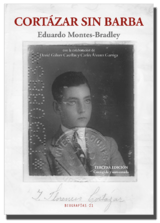
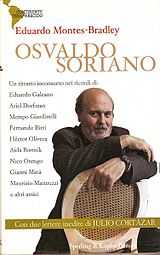
Los dedos del huracán. Short story. Children Literature. Included on "De Ola en Ola 3" School Textbook for Third Grade. Group Macmillian. Editorial Estrada S.A., Buenos Aires, Argentina. Illustrated by Eugenia Nobati. p. 62-67[109]
Cortázar sin barba. Madrid: Random House Mondadori. 2005. pp. 394 Hard Cover. ISBN 84-8306-603-3. In less than five hundred pages the author exposes the mechanisms used to build Cortázar: the myth, providing at the same time the tools to destroy the myth. The first edition of Cortázar sin barba was published by Sudamericana, Argentina, 2004. A Third Edition (revised) was presented in Barcelona by Pesódromo 21 on September 30, 2014.[110][111][112][113][114][115]
Água No Terceiro Milenio Bilingual Anthology of Short Stories. Selection of awarded works at the Literary Award "Agua no terceiro Milenio",[116] Brazil. Published in Portuguese and Spanish. Pilar Editors, Brasília, 2000. P. 142, 143, 144. Includes the short story "Das schwerste gewicht" previously published in "Its All a Lie" Ya se que todo es mentira, Editorial del Nuevo Extremo, Buenos Aires 1999.
Osvaldo Soriano: Un retrato. Buenos Aires: Grupo Editorial Norma. 2000. pp. 171 Rustic. ISBN 9879334353. Italian edition by Sperling & Kupfer Editori, Milan, Italy, 2001, 164pp. Translated by Gina Maneri. Collection: Continente Desaparecido, directed and coordinated by Gianni Minà ISBN 88-200-3201-5. The book summons a series of interviews including: Ariel Dorfman, Eduardo Galeano, Ana María Shua, Martín Caparrós, Fernando Birri, Aida Bortnik, Roberto Cossa, Liliana Hecker, Federico Luppi, Hector Olivera, Nico Orengo, Dalmiro Saenz, Gianni Minà and others. The interviews were previously documented by the author on a documentary film on same subject. There are also a few chapters, introduction and epilogue by Montes-Bradley with a significant number of footnotes and references. The book also includes correspondence between Osvaldo Soriano and Adolfo Bioy Casares, Julio Cortázar and Juan Gelman.[117][118][119]
Ya sé que todo es mentira (Its All a Lie). Short Stories. Editorial Nuevo Extremo, Buenos Aires, Argentina 1999. Some of the short stories included in this compilation have been originally published in literary magazines. Foreword by Osvaldo Bayer. 199 pp.
Senxo, Selected Poems. Editorial Grupo Archivo de Comunicación, New York, 1984. Foreword by Armando Tejada Gómez. Out of print.
Journalism
Montes-Bradley has contributed with the following publications: El País, Babelia,[120] Les cinemas de la Amerique Latine,[121] by the Association Rencontres Cinémas d'Amérique Latine de Toulouse France; La Jornada, México; the monthly review Latinoamérica e Tutto il Sud dell Mondo, Italy; and in Argentina with the literary magazine Esperando a Godot; the art-magazine Revista Lote, Venado Tuerto, Suplemento Radar published weekly by Página/12, El Amante de cine, "Diario Perfil", "Revista Ñ" Clarin,[122] Critica de Argentina; and La Nación. Montes-Bradley is also a frequent collaborator with the literary blog "Nación Apache"
His interventions in the media can be classified as: a. In-depth articles on subjects as diverse as the life of Dean Reed[123] in the Soviet Union, and the aftermath of the Battleship Potemkin;[124] b. Sudden and brief pieces on current affairs with a particular emphasis in domestic politics in Argentina. One of Montes-Bradley's bull's eye of choice appears to be the National Institute of Cinematography (INCAA) a government institution repeatedly denounced for its high levels of corruption, censorship and the discretionary handling of public resources. c. Letters to the Editor.In this the most singular form of interventionism Montes-Bradley has written a considerable number of letters to the editors becoming a regular de facto columnist.[125][126]
Photography
Montes-Bradley's photos have been published on La Nacion,[127] The Independent,[128] Deutsche Welle,[129] Diario Clarin[130] other newspapers[131] and magazines[132] as well as commemorative books such as "Escenas de la memoria. La Casa Argentina en la voz de sus antiguos residentes",[133][134] and "Aventura Turnberry Jewish Center 20th Anniversary".[135] Montes-Bradley portraits are preserved at the Claude Moore Health Sciences Library at the University of Virginia.
Appearances in other media
Margaux Hemingway from the series E! True Hollywood Story produced by E! Entertainment Television
Jorge Giannoni. NN, ése soy yo (NN, The One In The Picture Is Me). A film on Jorge Giannoni. Guest Appearance by EM-B as having personally known the protagonist. Dir by: Gabriela Jaime, Argentina, 2000.[136]
Derrumbe. Random House Mondadori, 2012. Eduardo Montes-Bradley is EMB, a fictional character in Daniel Guebel’s novel.
Mis escritores muertos. Mansalva Editorial, 2009. Eduardo Montes-Bradley is EMB, a semi-fictional character in Daniel Guebel’s road novel.
Notes
- ↑ Jefferson Trust Award, 2015. Awarded for “Monroe Film”. The award issued by The Trustees of the Jefferson Trust is shared with Stephen Plaskon, Soledad Liendo and Melissa Thomas Hunt.
- ↑ Condor de Plata by the Union of Critics of Argentina
- ↑ The 2015 Award Winners
- ↑ The Encyclopedia of Argentine Cinema by Adolfo C. Martinez, 2004. p. 136.
- ↑ A Dictionary of Argentine Films by Raúl Manrupe, Ma. Alejandra Portela. Published by Corregidor, 1995. pp. 16, 63, 109.
- ↑ Cornell University Library
- ↑ University of California, Center for Media and Independent Learning
- ↑ Binghamton University Libraries
- ↑ 9.0 9.1 Morris, Giles. "Local Filmmaker takes on the civil rights struggle..." C-Ville Weekly, November 1, 2012 p. 18
- ↑ "An Afternoon with Rita Dove & Julian Bond". Virginia Film Festival. November 8th, 2014. Charlottesville, Regal Theatre
- ↑ "Cinema como forma de escrita". Revista Continente. August, 2013.
- ↑ Suassuna, Marina: "Cineasta faz documentários sobre Ronaldo Correia de Brito e José Luiz Passos". Folha de Pernambuco, Recife, October 28th, 2014
- ↑ Thomas Osgood Bradley Foundation. Genealogical Research.
- ↑ "Nicolás Avellaneda" Colegio Nacional Nº 4. Public Education
- ↑ Page, JosephPeron: A Biography Random House; 1st edition (July 12, 1983)
- ↑ Maia, Luiza. "Assombraçoes de Cinema". Diario de Pernambuco. Supplement Viver. July 9, 2013. Recife, Brazil.
- ↑ El Heraldo del Cine, Vol 13. Buenos Aires, 1980.
- ↑ Macau, Clarissa. "Cinema como forma escrita" Revista Continente. August 7, 2013
- ↑ Turner Classic Movies
- ↑ 20.0 20.1 Museo del Cine Pablo C. Ducrós Hicken. Biblioteca y Centro de Documentación. Salmún Feijóo 555, 2º piso. Buenos Aires, Argentina.
- ↑ The Business of Film
- ↑ El Infierno tan temido. Diario Clarin, September 8th, 1996
- ↑ International Movie Data Base
- ↑ Bernárdez, Horacio. "El gordo cerraba bien". Pagina | 12. Buenos Aires
- ↑ Une interview avec Eduardo Montes-Bradley. Université Toulouse le Mirail, Toulouse. 2008
- ↑ Richmond International Film Festival. The 2015 Award Winners
- ↑ Les Yeux du Monde | Fine Arts Gallery
- ↑ 28.0 28.1 Filmakers Library, an imprint of Alexander Street Press. Official Website.
- ↑ Maurer. David. The Daily Progress. January 31st, 2014.
- ↑ N.S.W. "Rita Dove: Beloved UVA Professor, Pulitzer Prize Winner & Poet Laureate". February 25, 2014
- ↑ 31.0 31.1 University of Virginia. Department of English. Rita Dove. Audiovisual
- ↑ Montes-Bradley, Eduardo. "Rita Dove: La poeta de Barak Obama" La Nación|ADN . Buenos Aires, Argentina May 10, 2013
- ↑ Montes-Bradley, Eduardo. "Poesía y poder político". La Nación|ADN . Buenos Aires, Argentina May 10, 2013
- ↑ Film About Rita Dove Explores the Poet’s Formative Years (University of Virginia).
- ↑ Premier Announcement. Honoring Rita Dove: An American Poet. Community MLK Celebration, University of Virginia.
- ↑ United States Holocaust Memorial Museum
- ↑ Macau, Clarisa. Revista Continente. Cinema como forma de escrita. August 7, 2013. Recife, Pernambuco, Brazil.
- ↑ "Filmmaker produces documentaries on Ronaldo Correia de Brito and José Luiz Passos" Diario de Pernambuco | Cinema | October 27th, 2014
- ↑ Germano, Tiago: "Un biógrafo de lentes" | Vida & Arte | Jornal da Paraiba. Editor: André Cananéa | Sunday, November 2, 2014.
- ↑ Puffer-Rothenberg, M | Video Librarian. Film review. September 2013. USA
- ↑ "Les boîtes ouvertes de l’Amérique numérique. Aveux d’un documentariste indocile" Revue Annuelle de L'association Rencontres Cinémas D'Amerique Latine de Toulouse. Toulouse, France. Issue Number 21. p. 171
- ↑ Cineagenzia. "Lisboa" di Eduardo Montes-Bradley | Stati Uniti, 2013, 27 minuti | Anteprima Italiana
- ↑ "Cada pieza es de un valor incalculable".Diario Clarin, Revista Ñ. September 9, 2011.
- ↑ ¨Borges in Charlottesville" Virginia Magazine, UVA Alumni. Summer 2012. Arts, Page 61
- ↑ Zapata, Marcelo. "Jared Loewenstein: el guardián de Borges". Ambito Financiero. August 24, 2011.
- ↑ UVa. Special Collections Library UVa. Special Collections Library
- ↑ School of Engineering & Applied Science, University of Virginia. E-News Online. September 2011
- ↑ Zapata, Marcelo. "Waissman es como un Robinson devuelto al bullicio" Ambito Financiero, Nov. 25. 2010
- ↑ WPBT Channel 2 (PBS) Program Guide. November 2010.
- ↑ Heritage Film Project Official Site
- ↑ International Movie Data Base
- ↑ USC Shoah Foundation Institute testimony of Victor Cynamon
- ↑ Aventura News. Has Aventura Turnberry Jewish Center “Gone Hollywood”?
- ↑ Aventura News. February 2-8, 2011
- ↑ Heritage Film Project Official Site. The Films, credits.
- ↑ El Nuevo Herald. Revista Aplausos. By Olga Connor, Miami, January 7, 2010
- ↑ Catalogue and website for the Mar del Plata Film Festival, 2009
- ↑ Eduardo Montes-Bradley on his film "Evita" | Virginia Film Festival
- ↑ Schedule | Virginia Film Festival
- ↑ Konno, Kiyoshi. Illustrations by Shimano, Chie. "Che Guevara". Pinguin Group. New York, USA. Bibliography
- ↑ Guibert, Martine et al. "La bassin du Río de la Plata. Développment local et intégration régionale" Presses Universitaires Du Mirail. Toulouse, France. 2009. p. 201
- ↑ Daily Variety. Article by Jonathan Holland. April 24, 2007.
- ↑ Guibert, Martine; Carrizo, Silvina; Ligrone, Pablo and Mallard, Bruno. Le bassin du Rio de la Plata: Développement régional et intégration régionale. Page 201
- ↑ Diario Clarin. Suplemento especial | "Las diferentes caras del cine nacional" | March 29, 2007
- ↑ Agencia Nova. February 17th, 2007 | Espectáculos
- ↑ Montes-Bradley, Eduardo. "Samba On Your Fee" 2006 Testimony of Haroldo Costa with regards to the origin of Samba.
- ↑ WTJU 91.1FM Interview with Eduardo Montes-Bradley | February 12, 2014
- ↑ History 206.403 "Africans and their Descendants in Latin America" Professor Tamara J. Walker. University of Pennsylvania.
- ↑ "Espaço Cine Digital exibe filmes de documentarista argentino". Iparabiba, Brazil. Educação e Cultura. September 20, 2010.
- ↑ "Africans and their Descendants in Latin America" Professor Tamara J. Walker. University of Pennsylvania
- ↑ Olga Connor, "Miami en la cultura latinoamericana" El Nuevo Herald, (Miami Herald). June 1o, 2014.
- ↑ Ideografía de un mestizo, by Pilar Roca. p. 8
- ↑ Sebreli, Juan José El tiempo de una vida’'. Ed. Sudamericana, Argentina, 2005. p.186
- ↑ International Movie Data Base
- ↑ Gabin, Maria Jose. Perez Celis: Mi padre. p/251.
- ↑ Roca, Pilar "Las vidas paralelas de Montes-Bradley". Universidade Federal de Paraíba. Brazil.
- ↑ "Del papel al celuloide: escritores argentinos en el cine", by Agustin Neifert. La Crujía Ediciones, 2003. p. 361
- ↑ Boletín Octavio Paz. Vol. 1. Issue 1. April–May 2009. www.octaviopaz.org
- ↑ Zekmi, Silvia Nagy. Moros en la costa: orientalismo en Latinoamérica. Published by Iberoamericana, 2008. p. 194.
- ↑ Silva Costa, Júlia Morena. Cortázar: Cinema e Performance em Un tal Lucas. Published by Facultade de Letras da Universidade Federal de Minas Gerais. Belo Horizonte, Brazil 2009. Filmografía.
- ↑ "Moros en la costa: orientalismo en Latinoamérica" by Silvia Nagy-Zekmi. Iberoamericana. Madrid, 2008. Page 194
- ↑ ¨Moros en la costa: orientalismo en Latinoamérica. By Silvia Nagy, Iberoamericana, Madrid, Spain 2008. p.192
- ↑ International Movie Data Base
- ↑ Bayer, Osvaldo and Ferrer. Osvaldo Bayer íntimo: Conversaciones con el eterno libertario. Ediciones Madres de Plaza de Mayo, 2007. pp.17,18,298.
- ↑ Block de Behar, Lisa. Author´s Introduction. P. x . State University of New York, Albany, 2014
- ↑ Diccionario de directores del cine argentino by Adolfo Martinez. Ed. Corregidor. 221 pages, 2004, Buenos Aires, Argentina.
- ↑ Jorge Luis Borges as a Writer and Social Critic by Gregary Joseph Racz. Edwin Mellen Press, 2003. ISBN
- ↑ Xul Solar by Alvaro Abos. Editorial Sudamericana, 2004. ISBN
- ↑ Jorge Luis Borges: une autre littérature: (parcours d'une œuvre), by Jean-François Gérault. Published by Encrage, 2003. p. 168
- ↑ Farina, Alberto. El cine en Borges. Cuadernos del Centro de Estudios en Diseño y Comunicación. Cuaderno 27, Año XIX. Issue 27. p. 25. December 2008.
- ↑ AMV. "De Ideas y paradojas".Diario Clarín, Cine: Crítica. Buenos Aires Thursday, September 14th, 2000.
- ↑ "Harto The Borges: diez años después". Diario Clarín, Revista Ñ. Monday October 4, 2011. Escenarios/Cine.
- ↑ "Del papel al celuloide: escritores argentinos en el cine", by Agustin Neifert. La Crujía Ediciones, 2003. p. 48, p. 55.
- ↑ Carlos Gardel a la luz de la historia by Nelson Bayardo. Fundación Bank Boston, 2000. ISBN
- ↑ Brent J. Carbajal. Violentas imágenes de un tango peronista. Department of Modern and Classical Languages Western Washington University. Alpha, dic. 2007, no.25, p.185-191. ISSN
- ↑ Neyret, Juan Pablo Para textos bastan y sobran. Universidad Nacional de Mar del Plata. Espéculo. Revista de estudios literarios. Universidad Complutense de Madrid. Spain 2003
- ↑ Paz, Carlos. Efemérides literarias argentinas. Biblioteca Nacional; Sociedad Argentina de Escritores, 1999.
- ↑ Polo, David Prieto. La subversión de la historia: parodia, humor, cine y música en las novelas de Osvaldo Soriano. Universidad Complutense de Madrid. Spain. Facultad de Filología. Dep. de Filología Española IV. Madrid 2006. p. 21.
- ↑ Mesa Gancedo, Daniel. Vicissitudes of the Artificial Character in the Argentine Novel of the 19090's. p. 168. Ediciones Universidad de Salamanca. Spain. Am'erica Latina Hoy. Issue 30. Year 2002.
- ↑ De la fuga a la fuga: diccionario de films policiales. By Roberto Blanco Pazos, Raúl Clemente. Published by Corregidor, January 1, 2004. p. 427.
- ↑ "El próximo vecino de los Kirchner". Diario Perfil, December 11, 2006.
- ↑ Rocky Mountain News, July 22, 1991. Arts & Entertainment.
- ↑ Colorado Daily. Agugust 2-5, 1991 Vol. 98 No. 183
- ↑ Sunday Camera. Boulder, Colorado. July 14, 1991
- ↑ The Denver Post, September 25, 1992.
- ↑ The Profile. Denver, October 1992. Volume 15.
- ↑ Revista Ñ | Diario Clarin. Buenos Aires, Argentina. September 5, 2011
- ↑ Montes-Bradley, Eduardo. "Rozitchner íntimo en tres tomas continuas". Revista de Cultura Ñ. Ideas-Filosofía. Diaro Clarin. September 5, 2011
- ↑ Editorial Estrada. Catálogo 2010
- ↑ Anales de literatura hispanoamericana by Universidad Complutense de Madrid Cátedra de Literatura Hispanoamericana, Universidad Complutense de Madrid Departamento de Filología Española IV. Vol. )
- ↑ Julio Cortázar: El otro lado de las cosas by Miguel Herráez. Institució Alfons el Magnànim, Diputació de València,2001.
- ↑ Julio Cortázar y el hombre nuevo, by Graciela Maturo, 2004. p. 241.
- ↑ Broichhagen, Vera. "Julio Cortázar o las barbas del diablo". Cuadernos Lirico. Revista de la red interuniversitaria de estudios sobre las literaturas rioplatenses contemporáneas en Francia. Université Paris 8 Vincennes – Saint-Denis/Princeton University. October 11, 2012.
- ↑ Third Edition: Pensódromo 21. Barcelona, Spain. ISBN 8494247417 | 6.7 x 0.9 x 9.6 inches | 384 pages. Released on September 30, 2014
- ↑ Cortázar sin Barba Official Site | Pesódromo 21. Blog
- ↑ Premiaушes
- ↑ Osvaldo Soriano, by Cristián Montes. Published by RIL Editores, 2004. Original from the University of Michigan
- ↑ Osvaldo Soriano: Una contrautopía posmoderna, by Cristián Montes, Published by RIL Editores, 2004. pp. 45, 53, 87.
- ↑ Budassi, Sonia, "Más allá de la nostalgia". Diario Perfil. Buenos Aires, January 26, 2007
- ↑ Entrevista a Luis Harss | El País, Babelia | March 14, 2015
- ↑ Rueda, Amanda: "Las relaciones Norte-Sur en el cine contemporaneo" Revista CIDOB Center for International Affairs.December 2009. p.137
- ↑ Revista Ñ. "Cada pieza es de un valor incalculable" Buenos Aires, Argentina, September 9, 2011
- ↑ "El Elvis Rojo". Suplemento Radar (Nota de Tapa). Página/12. Buenos AIres, Sunday, January 23, 2005.
- ↑ "Marea Roja" Suplemento Radar (Nota de Tapa). Página/12. Buenos Aires, Sunday March 6th, 2005.
- ↑ Rueda, Amanda. "Las relaciones Norte Sur en el cine contemporáneo". Representaciones del "otro"en la construcción de redes transnacionales. Revista CIDOB d'Afaires Internacionals No. 88. pp. 137, 138, 140
- ↑ Bousquet, Franck. "Cinéma et identités collectives: actes du 3e Colloque de Sorèze" p.199
- ↑ "Rita Dove: la poeta de Barak Obama" Photos by Montes-Bradley. La Nacion. ADN | Cultura. Buenos Aires, Argentina. Friday, May 10th, 2013.
- ↑ Alison Entrekin. The Independent. November 18, 2013. Book review: Crow Blue, By Adriana Lisboa. Portrait of Adriana Lisboa in Boulder, Co. USA
- ↑ Saavedra, Carola. "Die Fiktion des Fremden". Deutsche Welle, Ausgabe 5, 2013 | Page 19. Portrait of Carola Saavedra in Berlin, Germany
- ↑ Leon Rozitchner | Photo by Eduardo Montes-Bradley
- ↑ Diario Perfil. Buenos Aires, Argentina. Sábado 11 de Junio de 2011. El Observador, page 50. Portrait of Ismael Viñas.
- ↑ We The People. The Publication of James Madison’s Montpellier. Orange, Virginia. Spring 2014. Credited on Cover photo. p. 3 top, p.4-5, p. 6, p.7, p.9, p. 19.
- ↑ "Escenas de la memoria. La Casa Argentina en la voz de sus antiguos residentes" Ministerio de Educación, Presidencia de la Nación. Buenos Aires, Argentina 2012. Portrait of Leon Rozitchner
- ↑ Ensemble. Revista electrónica de la Casa Argentina en París. Año 5 - número 11 - ISSN 1852-5911. Portrait of Leon Rozitchner
- ↑ "Aventura Turnberry Jewish Center 20th Anniversary" Stern | Bloom Media. Aventura, FL, USA 2011.
- ↑ "Jorge Giannoni. NN, That Is Me." Queen Mary, University of London, Library. Guillermo Olivera
References
- Roca, Pilar Las vidas paralelas de Montes-Bradley Grupo Archivo de Comunicación. New York, 2010. University of Virginia Libraries; University of Virginia Library; UVa Library
- Abos, Alvaro Xul Solar: Pintor del misterio. Sudamericana, 2004. p. 289
- Lindner, Franco Cooke: El heredero maldito de Perón: la biografía. Editorial Sudamericana, 2006
- Arnold, Jorge Revista de critica literaria latinoamericana.. Latinoamericana Editores.
- Nagy-Zekmi, Silvia Moros en la costa: Orientalismo en America Latina. Iberoamericana.p. 192.
- Sebreli, Juan JoseEl tiempo de una vida: Autobiografía. Editorial Sudamericana, 2005
- "Reviews on Latin American and Chinese Art by Eduardo Montes-Bradley" Art and Wealth
- Bustos, Graciela Audiovisuales de combate: Acerca del Videoactivismo Contemporáneo. Published by Centro Cult. de España, Bs.As., 2006. p. 83
- Kriger, Clara / Spadaccini, Silvana Páginas de cine. Archivo General de la Nación, República Argentina, 2003. p. 103
- Tiempo de hoy. Published by Ediciones Tiempo, S.A., Spain, 2005. p. 84
- Mazzeo, Miguel / Ramb, Ana María Osvaldo Bayer: Miradas sobre su obra. C.C.C., ED. del Inst. Movilizador de Fondos Coo., 2003. p. 96
- Neifert, Agustin, Del papel al celuloide: Escritores argentinos en el cine. La Crujía Ediciones, 2003. pp. 48, 49, 54.
- Di Benedetto, Antonio and Lebenglik, Fabian El Pentágono: Novela en forma de cuentos. Adriana Hidalgo Editores, 2005. p. 13
- Aguilar, Gonzalo Moisés Otros mundos: Ensayo sobre el nuevo cine argentino. Santiago Arcos Editor, 2006. pp. 228, 130, 231.
- Fernandez Naval, F.X. Respirar por el idioma: (los Gallegos y Julio Cortázar). Contributor Emilia Veiga Torre. Editorial Corregidor, 2007. pp. 14, 38, 192
- Versants. By Collegium Romanicum. Published by L'age d'homme, 2001. 262, 266.
- Nelson Bayardo and José Pedro Rilla Carlos Gardel: A la luz de la historia. Editorial Aguilar, 2000. p. 117
- María Gabriela Barbara, Cittadini. Vindicaciones del infinito.Fundación Internacional Jorge Luis Borges, 2003. p. 38
- Neifert, Agustín. Del papel al celuloide Edition: illustrated. La Crujía Ediciones, 2003
- Mesa Gancedo, Daniel Avatares del personaje artificial en la novela Argentina de los 90. America Latina Hy, 30, 2002, Ediciones Universidad de Salamanca. p. 168.
- Neyret, Juan Pablo. Para textos bastan y sobran. La conformación del espacio paratextual en Triste, solitario y final, de Osvaldo Soriano. Universidad Nacional de Mar del Plata.
- Sainz Borgo, Karina. "Julio Cortázar: franquista en Buenos Aires, marxista en Estados Unidos y burgués en Cuba"
- Montes-Bradley, Eduardo. "Notes On Myself"
- Les cinemas de la Amerique Latine
- The Filmakers Library
- Greenacord
- Thomas Osgood Bradley Foundation TOBF
- Mar del Plata Film Festival
|
